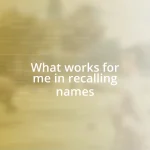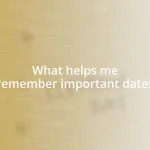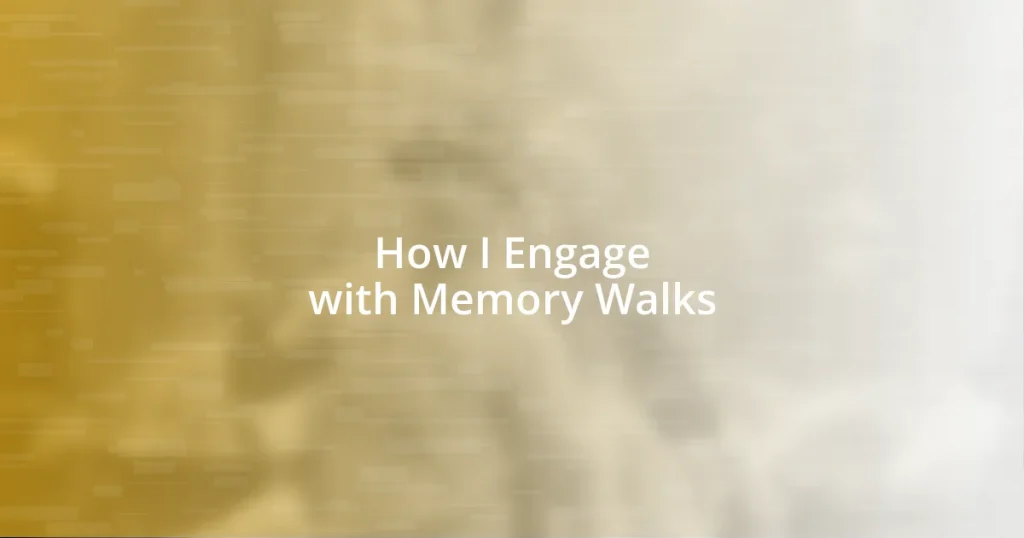Key takeaways:
- Memory walks facilitate deep emotional connections and storytelling among participants, enhancing relationships and promoting nostalgia.
- Preparation for memory walks involves selecting meaningful routes, documenting emotions, and inviting companions to strengthen shared experiences.
- Post-walk reflections, whether in informal settings or through group scrapbooks, reinforce the significance of shared memories and foster a sense of community.

Understanding Memory Walks
Memory walks are not just strolls down familiar paths; they are poignant journeys through time, igniting connections to our past. I remember my first memory walk vividly. I was accompanied by friends as we retraced the steps of our childhood playground. Each swing and slide triggered a wave of nostalgia, flooding my mind with laughter and innocent moments. Have you ever felt that rush of emotions when revisiting a place that holds so many memories?
These walks often serve as a bridge, linking generations as stories unfold with each step taken. I once joined a memory walk with my grandmother, listening as she shared tales of her youth. The joy in her eyes was infectious, revealing just how powerful these walks can be in strengthening bonds and creating understanding. Can you picture the depth of connection that occurs when we share memories?
Understanding memory walks means recognizing their role in healing and reflection. I find solace in revisiting places of significance during challenging times. They allow me to pause and reflect, reminding me of my personal growth and resilience. Have you ever found peace in a familiar space that embraced your memories?

Importance of Memory Walks
Memory walks hold profound significance for both individuals and communities. For me, they’ve been a source of connection not just to my past, but to others I share those moments with. I recall a time when I participated in a memory walk through my old neighborhood with coworkers. As we shared stories tied to each location, I felt our relationships deepen. It emphasized that every street corner can hold a different chapter of our lives, creating a tapestry of shared experiences.
Here are some key reasons why memory walks are important:
- Strengthens Relationships: They foster connections as shared stories can enhance understanding among participants.
- Promotes Healing: Revisiting places tied to our emotions can be therapeutic, helping us process experiences.
- Encourages Reflection: These walks allow for introspection, reminding us of our growth and experiences over the years.
- Cultural Preservation: Memory walks can preserve community history, offering new generations a chance to connect with their roots.
Engaging in a memory walk evokes an emotional richness that you can’t quite capture in words. Each step becomes a gateway to reflection and bonding, creating invaluable connections that linger far beyond the journey itself.

Preparing for a Memory Walk
To prepare for a memory walk, I always start by selecting a route that resonates with my experiences. It’s amazing how even the simplest places can spark profound memories. For instance, I once chose to stroll down the street where I had my first job, and just being there brought back such vivid memories of my teenage excitement and the people I worked with. Have you ever walked a familiar path and felt those emotions wash over you?
Next, I make sure to bring along a journal or even just my phone to document any emotions or thoughts that arise during the walk. On one memorable occasion, as I walked past a coffee shop where I used to share stories with friends, I pulled out my phone to jot down snippets of conversations I could recall. Later, revisiting those notes allowed me to savor the essence of those moments and feel a sense of gratitude for the connections I’ve made. How do you capture emotions during meaningful experiences?
Finally, I recommend going with someone who shares similar memories of the places we plan to visit. Last summer, I took a memory walk with an old school friend. We laughed, reminisced, and even retraced our steps as we wandered through our shared past. The beauty of experiencing these locations together is that it elevates the emotional depth of the walk. Have you thought about how shared stories can illuminate the significance of a walk?
| Preparation Tips | Personal Insight |
|---|---|
| Select a resonant route | Brings back personal memories |
| Document emotions | Enhances reflection for future |
| Invite a companion | Deepens connection through shared experiences |

Techniques for Engaging Participants
When engaging participants in a memory walk, I find that using visual prompts can be incredibly effective. During one of my recent walks, I brought along old photographs from the neighborhood, showcasing landmarks that no longer exist. As we gathered around each image, the group erupted with memories, sparking lively conversations that transformed our experience into a vibrant storytelling session. Have you ever noticed how a single image can unlock a treasure trove of shared memories?
Incorporating thematic storytelling also enhances participant engagement. For instance, I once organized a walk focusing on childhood adventures. As we strolled through parks and playgrounds, each participant shared their own favorite games and secret hideouts. This approach not only made the walk relatable but also fostered an atmosphere of warmth and nostalgia, urging others to reveal their own stories. Doesn’t it feel special when everyone’s voice adds a unique thread to the communal tapestry of memory?
Lastly, I believe in the power of interactive elements. During a recent memory walk, we stopped at various points to create a collective scrapbook, allowing participants to write down or draw their memories tied to specific locations. The tangible connection to our past became evident as we shared snippets and snippets of our lives with one another. Have you ever thought about how creative expression can not only capture memories but also strengthen bonds among participants?

Incorporating Storytelling in Walks
Storytelling truly breathes life into memory walks. I can still recall a beautiful afternoon when I decided to narrate tales from my childhood while walking along a familiar park trail. As I shared the story of that one summer spent making daisy chains with friends, I noticed faces lighting up as they connected with their own childhood memories. Isn’t it fascinating how one story can ripple out and inspire others to share their own experiences?
Another memorable moment happened when I incorporated local legends into our walk. As we paused by a historic site, I recounted the tale of a hidden treasure said to be buried nearby. The excitement was palpable; participants leaned in closer, their imaginations sparking. This blend of local lore and personal anecdotes not only deepened our connection to the area but also created a shared space where everyone felt encouraged to contribute. Have you ever found that stories have a way of transforming a simple walk into an adventure?
I often reflect on the emotional resonance that storytelling brings. There was a time when an older participant shared a poignant story about their first love as we passed a quaint little café. The emotions in the air were almost tangible, enveloping us in a shared sense of nostalgia and vulnerability. It struck me how storytelling not only honors our past but also weaves a rich tapestry of connection among us. Have you ever experienced that powerful moment when a story takes you back in time?

Post-Walk Reflection and Sharing
After the walk, I encourage everyone to sit together and reflect on their experiences. I recall a time when, at the end of a beautiful stroll, we huddled on a park bench, sharing what resonated the most. One participant spoke about how a seemingly mundane street corner ignited memories of their childhood pet. It’s amazing how a simple conversation can uncover layers of nostalgia, isn’t it?
I also find that sharing our thoughts in a more informal setting—for instance, over a cup of coffee—can deepen connections. I remember a cozy café where we gathered post-walk, and the atmosphere was charged with excitement. As stories poured out, laughter rang through the space, and it struck me how important it is to create a supportive environment where everyone feels comfortable to voice their memories. Have you noticed how ambiance can influence our willingness to share?
Furthermore, documenting these reflections in a group scrapbook has become a cherished tradition. After one particularly moving walk, the group collaborated to compile their thoughts, and it turned into a beautiful tapestry of emotions and experiences. I still flip through that scrapbook; it’s not just a record, but a reminder of the bonds we forged. Isn’t it interesting how preserving these moments amplifies their significance?















